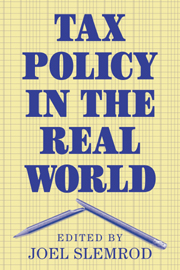Book contents
- Frontmatter
- Contents
- List of contributors
- 1 The real world of tax policy
- 2 Federal tax reform
- The corporate income tax: economic issues and policy options
- Changing views of the corporate income tax
- The American retail sales tax: considerations on their structure, operations, and potential as a foundation for a federal sales tax
- Would tax evasion and tax avoidance undermine a national retail sales tax?
- Life under a personal consumption tax: some thoughts on working, saving and consuming in Nunn-Domenici's tax world
- Living with the flat tax
- The international implications of consumption tax proposals
- 3 Federalism and subfederal taxes
- 4 Principles, politics, and the professors
- Index
Life under a personal consumption tax: some thoughts on working, saving and consuming in Nunn-Domenici's tax world
Published online by Cambridge University Press: 01 June 2010
- Frontmatter
- Contents
- List of contributors
- 1 The real world of tax policy
- 2 Federal tax reform
- The corporate income tax: economic issues and policy options
- Changing views of the corporate income tax
- The American retail sales tax: considerations on their structure, operations, and potential as a foundation for a federal sales tax
- Would tax evasion and tax avoidance undermine a national retail sales tax?
- Life under a personal consumption tax: some thoughts on working, saving and consuming in Nunn-Domenici's tax world
- Living with the flat tax
- The international implications of consumption tax proposals
- 3 Federalism and subfederal taxes
- 4 Principles, politics, and the professors
- Index
Summary
To tax plans old and new, I bring the certainty of a famous New Yorker cartoon. Three staff members are reporting to their senator. The senior staffer sums up: “Sir, we've come to the conclusion that it's absolutely impossible to assemble a tax plan that doesn't benefit the rich.”
At the threshold, I am told, I am to assume that in fall 1995, effective January 1, 1996, the 104th Congress enacts and President Clinton signs into law the USA Tax Act of 1995, S. 722, precisely in the 290-page form this grand legislation was introduced on April 25, 1995 by Senators Sam Nunn (Democratic-Georgia), Pete Domenici (Republican-New Mexico), and Bob Kerrey (Democratic-Nebraska). This exorbitant assumption embraced, my task is to imagine plausible answers to the simple question, “And then what happened?”
Forecasting the tax bar's delighted response to a truly sweeping and novel legislative proposal barely off the ground is great fun. The legislation seems unlikely of enactment, surely unlikely of enactment in the form introduced, and therefore none ever will prove how wrong I was. Thus comforted, I proceed to a selective review of S. 722 and then hazard some tax planner responses, but preface the entire exercise with what is intended as a provoking observation. The Nunn-Domenici tax world is one in which municipal bonds pay interest in even years only, executive compensation and the yield on at least one class of each corporation's stock is paid only in odd years, and the rich with borrowed money buy raw land or works of art they admire but may not expect to keep forever.
- Type
- Chapter
- Information
- Tax Policy in the Real World , pp. 77 - 94Publisher: Cambridge University PressPrint publication year: 1999



